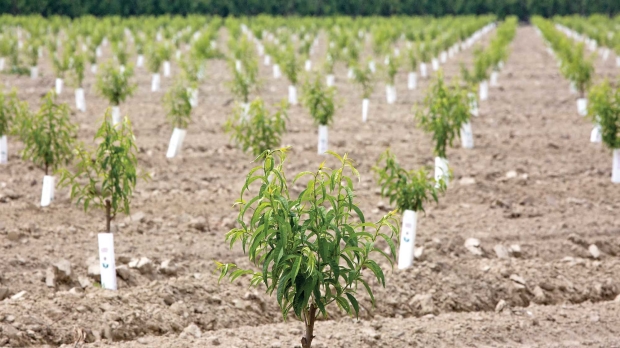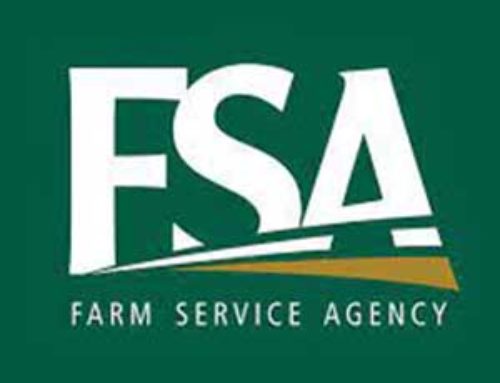
A newly planted cling peach orchard near Reedley, California on April 9, 2015. (TJ Mullinax/Good Fruit Grower)
Stronger prices for cling peaches seem to have prompted California growers to plant more trees, which should slow the industry’s long-term slide in acreage.
The rising price was triggered by long-term falling production as growers turned to crops that produced more income and could be produced with less labor.
Water supplies for peach production and the prolonged California drought have not really been the limiting factor for growers, according to Rich Hudgins, president and CEO of the California Canning Peach Association. Other forces were at work.
“Nearly all peaches are picked by hand, and thinned by hand as well, and the growing uncertainty about the future labor supply in California has been a big part of the reluctance to plant more peaches,” he said. “And there is currently a huge disparity in margins. Growers can do better planting walnuts and almonds, getting more income per acre without the labor headaches.”
Cling peaches are grown in California’s Central Valley from about 60 miles north of Sacramento to nearly 200 miles south of the city, in an area served both by irrigation districts and private wells.
More than half the production is in the Yuba City/Sutter County area. By using a combination of varieties and locations, the harvest and processing season can be spread over two months.
Cling peach prices have been slowly trending upward in the past few years. Processors paid $237 a ton for cling peaches in 2005 and $379 in 2014. There was a bigger jump this year; processors agreed to pay $460 a ton for peaches.
The California cling peach industry consists of approximately 400 growers producing on nearly 19,000 acres. The peach harvest typically starts around the Fourth of July and runs through Labor Day.
The association released its 2015 “prethinning crop estimate” on May 15, estimating the coming crop at 342,500 tons, 5.6 percent more than last year, mostly based on better yields per acre. Yields are estimated at 18.3 tons per acre, 11 percent higher than last year.
The last big year for cling peach planting in California was 2000, when 4,150 acres were planted. Since then, the acreage base has fallen, and so has tonnage. Growers produced 530,000 tons in 2004 on about 30,000 acres. By 2014, tonnage was down to 324,000 tons produced on 19,000 acres.
Then, Hudgins said, in 2014 growers increased their plantings, putting in 1,220 acres. Growers intended to plant 1,075 acres this year.
Canned
Almost all of California’s cling peaches are canned, and the decline in production is parallel to the decline in consumption of canned fruits and vegetables in general, he said.
A good part of the association’s website (calpeach.com) is devoted to information addressing the “consumer misperception” that fresh fruits and vegetables are more nutritious and healthier than canned or frozen products.
So in winter consumers are more likely to eat a peach imported from Chile than a domestically produced canned peach—unless they are eating in the school lunch program.
“A lot of our product goes into the institutional food service market, the largest segment of which is schools,” Hudgins said. “School feeding programs rely on canned and frozen products, which are highly cost-effective.”
Consumers have been led to believe that canned fruits are highly processed, less nutritious, and filled with added sugar and preservatives, Hudgins said.
In the May 15 newsletter Peach Fuzz, he quotes Cornell University researcher Dr. Brian Wansink, director of Cornell University’s Food and Brand Lab.
“Consumers need to get out of the mindset that only fresh fruits and vegetables are healthy,” Wansink said. “People have deceived themselves that fruits and vegetables have to be fresh. Canned and frozen have just as much nutrition, if not more.”
Wansink served as executive director of the USDA’s Center for Nutrition Policy and Promotion, the federal agency in charge of developing the 2010 Dietary Guidelines for Americans.
Consumers using fresh produce often waste more in food preparation, keep it longer before eating it, and end up eating food of lesser quality than canned or frozen food harvested at the peak of quality and processed immediately, he said.
The California Canning Peach Association, located in Sacramento, is a cooperative formed in 1922 to find contracts for cling peach growers and negotiate on their behalf for price and other terms of sale. It is the oldest such bargaining association in the United States, Hudgins said. The association represents about 80 percent of the state’s total cling peach production. •






[…] California cling peach growers plant more trees as prices improve A good part of the association's website (calpeach.com) is devoted to information addressing the “consumer misperception” that fresh fruits and vegetables are more nutritious and healthier than canned or frozen products. So in winter consumers are more … Read more on Good Fruit Grower […]
Where can I buy some CLING peaches, the kind that are very hard and bright yellow/gold. Our family used to preserve those and they were the MOST DELICIOUS peaches, both fresh and canned.
Is there a place to buy some near Tulare, Visalia, or Fresno?
Thanks. I have been trying to find these for years.
~Kata
I’m looking to buy a Sims cling peach tree. Do you know where I can’t find one?
Thank you